MAY 2020 – AUGUST 2020 RESEARCH HIGHLIGHTS
Updates from Faculty Labs

Hemali Phatnani (l) and CZI Neurodegeneration Challenge Network grant partner Liam Holt, PhD
Hemali Phatnani Awarded CZI Neurodegeneration Challenge Network Grant for Collaborative Research Project with NYU’s Liam Holt for In-depth Study of Live Neuron Cells in Real Time
The cellular framework of neurons is an incredibly crowded, complex, bustling environment, so full of molecules and organelles that the system is close to jamming. Is overcrowding a key factor that causes cellular components to stick together, leading to protein aggregate formation and disease onset? Is Alzheimer’s disease the result of crowding becoming even more dense as we age, causing neurons to shut down?
Those are the biological questions that Hemali Phatnani, PhD, Director, Center for Genomics of Neurodegenerative Disease, NYGC and Liam Holt, PhD, Assistant Professor, Institute for Systems Genetics, NYU School of Medicine will explore in a collaborative project that was awarded a pilot grant through the Chan Zuckerberg Initiative’s Neurodegeneration Challenge Network program in August.
Their award-winning project, “The Physical Biology of Neurodegeneration,” will utilize a mix of emerging new technologies, including cutting-edge microscopy techniques, genetically encoded nanoparticles, and spatial transcriptomics, to track what’s happening inside neurons during phases of protein aggregation. The team hypothesizes that features of cell types, genetics, signaling, and the mechanical environment of the cell come together to impact molecular crowding and aggregation in cells. While protein aggregation has been a topic of intense study, this approach is unique in being able to monitor these cellular events in live cells in real time.
CZI’s Neurodegeneration Challenge Network program seeks to bring together experimental scientists from diverse research fields, along with computational biologists and physicians, to understand the fundamental biology of neurodegenerative diseases and develop new strategies for treatment and prevention.
“My lab is new to the neurodegeneration field,” Dr. Holt noted in his project summary to CZI. “Working with Hemali Phatnani, we have an amazing opportunity to combine her deep understanding of the genetics of ALS with our approaches in biophysical analysis. This kind of bridging of fields is crucial to make new discoveries.” Read more about this award-winning project here.
- Hemali, who holds a joint appointment as Assistant Professor of Neurological Sciences in the Department of Neurology, Division of Neuromuscular Medicine, at Columbia University, is a senior author and CGND lab team members are among the contributors to the collaborative study, Cell Type-Specific In Vitro Gene Expression Profiling of Stem Cell-Derived Neural Models, published in Cells in June. Included as part of a special issue focused on neuron-glia interactions, the paper is the multi-institutional research team’s report on extension of the RiboTag system, first developed to achieve cell type-restricted expression of epitope-tagged ribosomal protein (RPL22) in mouse tissue, to a variety of in vitro applications, including immortalized cell lines, primary mouse astrocytes, and hiPSC-derived neurons. The study’s first author is James Gregory, PhD, formerly NYGC Staff Scientist at CGND, now Research Investigator at Arvinas, the New Haven, Connecticut-based biotechnology/pharmaceutical company. CGND’s Emily Hoelzli, Research Associate; Catherine Braine, Graduate Student; Miguel Cuevas, Research Technician; Güney Akbalik, PhD, Postdoctoral Fellow; and Kristy Kang, PhD, Senior Associate Scientist, are among the study’s co-authors.
- RNA sequencing of postmortem human brain samples from the NYGC ALS Consortium cohort, which is organized and maintained by the CGND, was among the key data analyzed for the study Truncated stathmin-2 is a marker of TDP-43 pathology in frontotemporal dementia, published in Journal of Clinical Investigation in August. Therapeutics are being investigated to target the two main proteins associated with frontotemporal dementia (FTD) subtypes: TDP-43 (FTLD-TDP) and tau (FTLD-tau). Yet testing in clinical trials has been hamstrung by the inability to distinguish between these two types in patients. The uncovering of this biomarker by this international research team, led by researchers at the Mayo Clinic, Icahn School of Medicine of Mount Sinai, and the Queen Square Institute of Neurology, in London, UK, will help overcome such barriers. CGND authors of this study include Hemali as well as Demetra Catalano, Research Associate; Duyang Kim, Senior Regulatory Affairs Coordinator; Nadia Propp, Scientific Research Manager; Samantha Fennessey, Scientific Project Manager; and Delphine Fagegaltier, PhD, Staff Scientist, Functional Genomics.
Marcin Imielinski Co-Leads WCM’s COVID-19 Shotgun Transcriptomics and Rapid Diagnostics Study

NYGC Core Faculty Member Marcin Imielinski, MD, PhD, has been co-leading what has been a rapid-paced study supporting the development of a rapid response test for COVID-19 led by Weill Cornell Medicine (WCM) colleague and NYGC Affiliate Member Chris Mason, PhD.
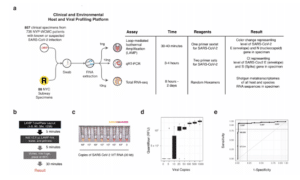
The study of the test, which leverages loop-mediated isothermal amplification (LAMP), a rapid gene identification technique, and indicates a positive result with a color change, was first posted as a pre-print in late April. The pre-print outlines the team’s design of a fast (30-minute) colorimetric LAMP test for SARS-CoV-2 infection from naso/oropharyngeal swabs, plus its large-scale shotgun metatranscriptomics platform (total-RNA-seq) for host, bacterial and viral profiling. The research team posted four “new results” updates to their pre-print within the following few weeks. On May 20, the test became the first LAMP test approved by the FDA for emergency use authorization, the result of what Dr. Mason appropriately heralded as a “rapid-pace partnership” between Color Genomics, the genetic testing company; the Broad Institute; New England Bio Labs; the Department of Pathology & Laboratory Medicine at WCM and NewYork-Presbyterian Hospital; and the Mason Lab.
The Imielinski Lab’s contributions to the study have been focused on analysis of clinical samples. The current and fifth version of the pre-print reflects analyses conducted on now some 500+ additional total RNA-seq clinical specimens (857 instead of 338 since the original pre-print). The expanding sample set led to ever-deeper analyses of data, including of ACE2 pathway activation, the biochemical pathway that appears to be central to COVID-19, in the host transcriptome. The team identified a variant (25563G>T) enriched in NYC cases that originated in Western Europe and showed a bicoastal increase following the NYC outbreak. The team’s studies also reveal specific host responses in interferon, hematological and olfaction pathways, and examine risks associated with use of ACE inhibitors and angiotensin receptor blockers. Together, these findings provide actionable applications to SARS-CoV-2 diagnostics, public health, and new therapeutic targets.
Marcin is a corresponding author of the study, with Imielinski Lab team members Joel Rosiene, a SUNY Downstate School of Medicine medical student working in the lab, and Alon Shaiber, PhD, Genomic Scientist, NYGC/WCM, among the study’s co-authors.
In other recent lab news, Marcin and Aditya Deshpande, a PhD student in the lab, gave talks on Pore-C, the chromatin capture method developed by Imielinski Lab in partnership with Oxford Nanopore Technologies, at the Biology of Genomes meeting held virtually by Cold Spring Harbor Laboratory in May and Oxford Nanopore Technologies’ London Calling 2020 online event in June, respectively.
Knowles Lab Posts First Lab Pre-Print on “Bimmer,” Tool to Estimate Causal Networks in Population-Scale Bio-Banks
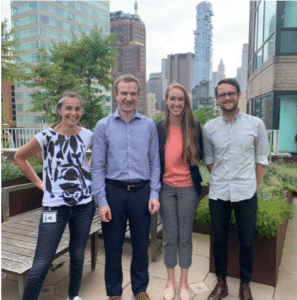
David Knowles (second from left) with lab team members Laura Pereira, Megan Schertzer and Brielin Brown.
In June, the Knowles Lab posted its first major pre-print, on Phenome-scale causal network discovery with bidirectional mediated Mendelian randomization. The study, led by Brielin Brown, PhD, Postdoctoral Research Scientist details “bimmer,” a new statistical tool to improve the ability to make causal inferences among wealth of variables of traits, biomarkers, and genetic variation found in population-scale biobanks. Mendelian randomization (MR) is a class of statistical analysis methods often used for inferring causal effects in observational data, but relies on assumptions that can have limitations. For example, MR estimates only the total effect of one trait on another, while these effects may also be mediated by other factors. To tackle this limitation, Brielin and David developed a two-stage framework: first calculate the total casual effect of every phenotype on every other, then approximately invert that matrix to produce a causal network. They call this framework bi-directional mediated Mendelian randomization, or “bimmer,” and introduce novel methods for both components.
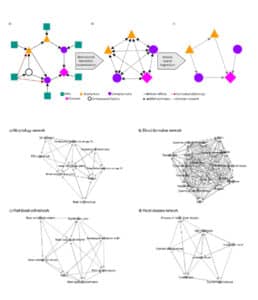
Figures from the “bimmer” study
The team conducted extensive simulations to demonstrate that bimmer was able to uncover causal network structures even in the presence of non-causal genetic correlations and for many different network architectures. They applied bimmer to 405 phenotypes from the UK Biobank, arriving at interpretations that lend causal support to several recent observational studies. For example, they found evidence for a causal effect of leukocyte count on various personality traits (such as “worrier,” etc.) found in biobank data, adding to a growing body of literature on the relationship between inflammatory biomarkers and personality. Similarly, they demonstrated causal support for recent observational studies linking increased testosterone to lung cancer risk after controlling for smoking status and mouse studies linking decreased testosterone to asthma risk. “Super clever approach for a very challenging problem,” was how one commentator responded to David’s tweetorial on the pre-print. The code for bimmer is available at: https://github.com/brielin/bimmer.
In late August, David received notice that he and collaborator Towfique Raj, PhD, a core faculty member at Mt. Sinai’s Ronald M. Loeb Center for Alzheimer’s Disease, were awarded a U01 grant from the National Institutes of Health for their project “Learning the Regulatory Code of Alzheimer’s Disease.” The goal of this research is to use machine learning algorithms and build computational models to work out which genetic differences in the genomes of Alzheimer’s disease patients might have caused their disease. The proposed study seeks to uncover what genes, pathways, and molecular mechanisms are involved in Alzheimer’s that will provide novel therapeutic targets for patients.
In other lab news, “Determining causal interactions learned by genomic deep learning models with in silico mutagenesis and Mendelian randomization,” a paper co-authored by David with Knowles Lab student Stephen Malina, was an accepted submission at the International Conference on Machine Learning 2020 Workshop on Computational Biology held this July. Nasrine Metic, a visiting MS student from Ecole Polytechnique Fédérale de Lausanne (EPFL) also successfully (and remotely!) defended her thesis on “Statistical models for condition-specific alternative splicing.” David is also a co-organizer of 15th Machine Learning in Computational Biology Conference, which will be a two-day virtual conference in November.
Landau Lab-Developed WGS Liquid Biopsy Method Showcased in Nature Medicine;
C2i Genomics Technology Spinout Receives $12M Series A Financing
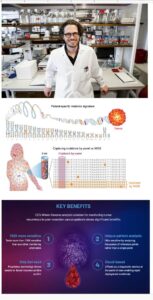
June 2020 was a milestone month for the lab of NYGC Core Faculty Member Dan Landau, MD, PhD: The study of its whole genome sequencing liquid biopsy method was published in Nature Medicine, and C2i Genomics, the spinout company founded on this technology, raised $12 million in Series A financing and is now embarking on international validation trials.
>While other liquid biopsy methods target a handful of specific genes or hotspots in the genome where cancer-associated mutations are expected, the Landau Lab-developed technique involves the sequencing of all circulating DNA in a patient’s blood sample. “It occurred to us that in some cases, it would be better not to look at a few DNA hotspots very thoroughly, but instead to make the most of available tumor DNA by detecting mutations across the entire genome,” said Dan, who holds a joint appointment at WCM, in the WCM news story about the study.
The technique creates a “mutational fingerprint” — a list of all the mutations in an individual’s tumor — that allows for ultra-sensitive detection of tumor DNA in the patient’s bloodstream. In the study, the researchers trained an algorithm to compare these fingerprints with DNA from blood samples and identified tumor DNA even when it comprised only 0.001% of the total DNA in the bloodstream. Such ultra-sensitive detection could help to determine whether people who have had tumor-removal surgery are cancer-free or need further treatment. “In most areas of medicine, treatments are guided by ongoing disease monitoring with blood tests or other methods,” Dan notes. “Solid tumor oncology has been an exception, but we’re hoping that our new technology will help close that gap.” Dan is senior author on the Nature Medicine study as well as serving as Scientific Co-Founder and Scientific Advisory Board Member of C2i Genomics. The study’s first author is former Landau Lab team member Asaf Zviran, PhD, now Chief Executive Officer and Chief Scientific Officer of C2i Genomics. See the complete list of co-authors, which includes Landau Lab and NYGC Computational Biology team members, here.
In other lab news:
Dan is co-author of the study Epigenomically Bistable Regions across Neuron-Specific Genes Govern Neuron Eligibility to a Coding Ensemble in the Hippocampus, published in Cell Reports in June.
Together with a team led by Mt. Sinai’s Chiara Giannarelli, MD, PhD, Dan is a Chan Zuckerberg Initiative grantee for a project to develop single-cell methods to study inflammation. The award-winning project is one of 29 inflammation research projects funded by CZI in late April.
In August, Dan received a 2020 Vallee Scholar Award to support his studies on somatic gene mutations in single cells. Also that month, the lab team’s review paper Integrating genetic and non-genetic determinants of cancer evolution by single-cell multi-omics was published in Nature Reviews Genetics. Dan is senior author; Anna Nam, MD, Clinical Postdoctoral Fellow, and Ronan Chaligne, PhD, Postdoctoral Fellow, are co-authors.
Federico Gaiti, PhD, Postdoctoral Fellow, received a NIH Pathway to Independence Award (K99/R00) from the National Cancer Institute in April.
Anna received a Career Award for Medical Scientists from the Burroughs Wellcome Fund in May.
Adam Widman, MD, Medical Oncology Fellow, received a Young Investigator Award from the American Society of Clinical Oncology in June.
Dan was also recently selected as a member of the American Society for Clinical Investigation and the advisory board of the Cell Press journal Cancer Cell.
Tuuli Lappalainen Contributes to ICDA and “Corona Free Finland” Reports; Lab Engages in New COVID-19 Studies
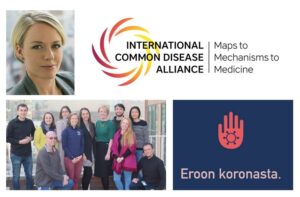
NYGC Core Faculty Member Tuuli Lappalainen, PhD, is co-author of a white paper, issued in July, from the International Common Disease Alliance (ICDA) that articulates a “vision for the next phase of common complex disease genetics — to accelerate progress in moving from Maps to Mechanisms to Medicine.” Tuuli co-chairs the ICDA Mechanisms working group and serves as a member of the organizing committee. ICDA is a scientific forum comprising international stakeholders across academia, medicine, biopharma, tech companies, and funders. The white paper’s recommendations outline bold scientific projects that form a roadmap for the next five to 10 years in complex disease genetics, including development of foundational genetic and genomic resources; critical computational and experimental tools; activities to propel therapeutics; important areas for new research and training; and strategies to promote global equity. The white paper is available at icda.bio/.
Tuuli, who holds a joint appointment Associate Professor of Systems Biology at Columbia University, is also one of the leading members of the multidisciplinary group of experts that is advocating for a stronger COVID-19 response policy in Finland. The team released a comprehensive report, Corona Free Finland, in early June, which made a significant impact on the national discussion and policy, and is now engaged in efforts to combat a second wave of the epidemic. The July report and other information is on the website eroonkoronasta.fi/. (The Finnish-to-English translation of eroon koronasta is “getting rid of corona.”)
In the wake of the COVID-19 epidemic, Silva Kasela, PhD, Postdoctoral Research Associate, and Tuuli have been engaged in a new collaboration with colleagues from UC San Francisco as well as other universities to analyze genetic and non-genetic risk factors of COVID-19 infection. Their analysis of a unique transcriptome data set of bronchial epithelium – the primary site of COVID-19 infection – will be available as a pre-print shortly.
In other lab news, Dafni Glinos, PhD, Postdoctoral Researcher, gave presentations on “Long-read sequencing of human tissues to study allelic effects on transcriptome structure,” at The Biology of Genomes meeting in May and Oxford Nanopore Technologies’ London Calling conference in June, both held virtually. The video of Dafni’s London Calling presentation is available here. Samuel Kim, a PhD student from Harvard, has been doing research in the lab this summer.
Tuuli is also co-organizing, with NYGC Core Faculty Member Neville Sanjana, PhD, the next offering of their popular Genomic Innovation graduate course for the fall 2020 semester. For the latest information on the course, visit its website, https://genomicinnovation.org/.
Neville Sanjana Receives 2020 Cancer Research Institute Technology Impact Award; Lab Decodes New Spike Mutation in Coronavirus
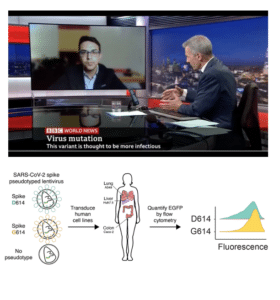
On June 15, NYGC Core Faculty Member Neville Sanjana, PhD, first posted a pre-print of a study conducted in his lab that the now-dominant G variant in the Spike protein of the coronavirus significantly impacts how well the virus infects human cells. Since then, there has been enormous interest in the work, and Neville has been asked to discuss the implications of this research for disease progression, vaccine development, and clinical therapies. Key interviews and stories to date include The Washington Post, a BBC World News TV interview, and most recently a CNBC report. The lab’s work on this study (see a figure from the pre-print at right) is ongoing, along with other work from the lab to understand key host genes involved in viral infection. The Spike mutation work was led by Zharko Daniloski, PhD, Postdoctoral Scientist in the Sanjana Lab, along with a team of collaborators from Ben tenOever’s lab (Mt. Sinai) and Gira Bhabha’s lab (NYU).
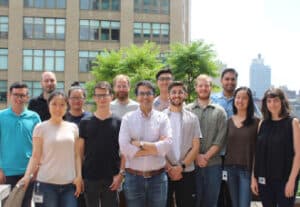
In August, the Cancer Research Institute announced that the Sanjana Lab received a 2020 Technology Impact Award to support pancreatic cancer immunotherapy research. The team’s goal is to combine genome engineering and single-cell analysis in primary human T cells to identify new genes that enhance the effectiveness of CAR T-cell therapy for pancreatic cancer. This approach may open novel avenues for the development of improved immunotherapies capable of overcoming immunosuppressive tumor microenvironments for many solid tumors and give new insight into fundamental mechanisms of a successful immune response. For more details, read the August 5 description on the NYGC website.
In May, the lab posted a pre-print of the study Automated design of CRISPR prime editors for thousands of human pathogenic variants on bioRxiv. The study was co-led by John Morris, PhD, Postdoctoral Scientist, and Jahan Rahman, an NYU undergraduate working in the lab. Check out the combined thread of John and Neville providing commentary on this study here. NYU Biology PhD student Xinyi (Cathy) Guo was also a co-author.
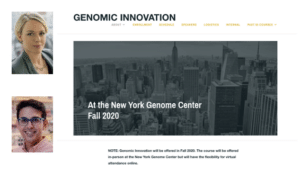
Neville, who holds joint appointments at NYU and NYU School of Medicine, is also co-organizing, with NYGC Core Faculty Member Tuuli Lappalainen, PhD, the popular Genomic Innovation graduate course for the fall 2020 semester. This year will be the third year that Neville and Tuuli have taught Genomic Innovation. The course, which consists of a combination of lectures and discussions with guest speakers, as well as group projects, individual assignments, and other interactive classroom activities, is eligible for credit or transfer credit at any NYC-area graduate school. For the latest information on the course, visit its website, genomicinnovation.org/.
Over the summer, the Sanjana Lab welcomed Lu Lu, a new laboratory associate, and hosted Camila Bolle as part of the NYU Summer Undergraduate Research Program. Camila worked closely with NYU Biology PhD student Akash Sookdeo on long-read sequencing and is returning to the College of New Jersey in the fall.
Satija Lab Updates
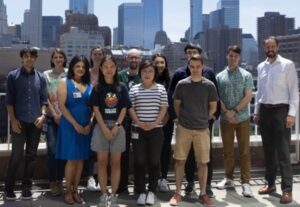
NYGC Core Faculty Member Rahul Satija, PhD, (l) who holds a joint appointment as Associate Professor at the Center for Genomics and Systems Biology at NYU, with his lab team.
Bingjie Zhang, PhD, a Postdoctoral Fellow in the Satija Lab, has been awarded a Jane Coffin Childs Memorial Fellowship. The award will support her collaborative research between the Satija Lab and Dan Littman’s lab at NYU. Bingjie will apply new genomic spatial profiling technologies, such as SLIDE-Seq, to understand the contribution of tissue organization and cell-cell interactions in autoimmune disease models.
Work from the lab was published as part of the following manuscripts:
- Papalexi E, Mimitou E, Butler A, Foster S, Bracken B, Mauck WM, Wessels H, Yeung BZ, Smibert P, Satija R. Characterizing the molecular regulation of inhibitory immune checkpoints with multi-modal single-cell screens. (bioRxiv).
- Wu L, Hollinshead KER, Hao Y, Au C, Kroehling L, Ng, C, Woan-Yu L, Li D, Silva HM, Shin J, Lafaille JJ, Possemato R, Pacold ME, Papagiannakopoulos TY, Kimmelman AC, Satija R, Littman DR. Niche-Selective Inhibition of Pathogenic Th17 Cells by Targeting Metabolic Redundancy. (Cell).
- Groen SC, Calic I, Joly-Lopez Z, Platts AE, Choi JY, Natividad M, Dorph K, Mauck WM, Bracken B, Cabral C, Kumar A, Torres RO, Satija R, Vergara G, Henry A, Franks SJ, Purugganan MD. The strength and pattern of natural selection on gene expression in rice. (Nature).
Updates From Research Sequencing & Analytics, Clinical Lab, and Technology Innovation Lab
Research Sequencing & Analytics Teams: Providing a “Gold Standard” of Genomics Expertise
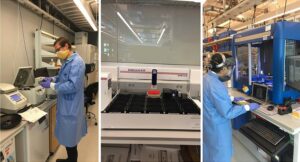
NYGC Production Lab team members Jonathan Gaige and Robert Furatero (l-r) preparing COVID-19 patient samples for sequencing.
NYGC’s Research Sequencing & Analytics team (Bioinformatics, Computational Biology, and Production Lab/Sequencing Operations) has been deploying its expertise to support the NYGC’s new COVID-19 genomics research. To date, over 1,600 COVID research samples have been sequenced at the NYGC, including samples for COVID-19 Genomic Research Network studies as well as external groups also working on understanding other aspects of the pandemic including treatment options. Also included in this sequencing work is sequencing COVID-19 host and viral samples as part of the partnership between the New York State Department of Health, the NYGC, and The Rockefeller University to better understand COVID-linked illness in children, the initiative announced by Governor Cuomo in early May.
As a co-principal investigator of the Polyethnic-1000 project to study cancer in New York’s ethnically diverse, underserved patient populations, Nicolas Robine PhD, Director, Computational Biology, is engaged in the project’s next set of research studies, which were reviewed by an external review committee in early August and are being considered by the P-1000 leadership group, and will be announced in September. This next phase follows the completion of the project’s first-phase retrospective study and build-out of pipeline, protocols, and collaborative framework earlier this year.
The NYGC Bioinformatics team is also involved in a wide range of other research projects, with a significant set of these studies published as pre-prints and in scientific journals over the last several months. In addition to contributing to the study of the Landau Lab-developed liquid biopsy method, published in Nature Medicine in June, the team’s latest pre-prints and publications include the following:
- Benchmarking challenging small variants with linked and long reads, posted to bioRxiv in July. Giuseppe Narzisi, PhD, Lead Bioinformatics Scientist; Marta Byrska-Bishop, PhD, Bioinformatics Scientist; Wayne Clarke, PhD, Bioinformatics Scientist; and Uday Evani, Senior Software Engineer, are among the coauthors of this study that substantially expands the capabilities of Genome in a Bottle benchmarks, which are widely used to validate clinical sequencing pipelines and develop new variant calling and sequencing methods.
- Multi-Platform Assessment of DNA Sequencing Performance using Human and Bacterial Reference Genomes in the ABRF Next-Generation Sequencing Study, posted to bioRxiv in July. Giuseppe, Wayne, and Marta are also contributors to this Association of Biomolecular Resource Facilities Next-Generation Sequencing phase II study, led by NYGC Affiliate Member Chris Mason, PhD, of Weill Cornell Medicine, to measure quality and reproducibility of DNA sequencing. A total of 202 datasets were generated to investigate the performance of a total of 16 sequencing platforms, including mappability of reads, coverage and error rates in difficult to sequence genomic regions, and detection of small-scale polymorphisms and large-scale structural variants.
- Somatic variant analysis of linked-reads sequencing data with Lancet, posted to bioRxiv in July. Giuseppe and Senior Bioinformatics Programmer Rajeeva Musunri are senior author and first author, respectively, of this study that extends Lancet, the now-widely used variant caller developed by the NYGC Bioinformatics team, to support the analysis of linked-reads sequencing data. By seamlessly integrating barcodes and haplotype read assignments within its colored De Bruijn graph local-assembly framework, Lancet computes a barcode-aware coverage and identifies variants that disagree with a local haplotype structure.
- A crowdsourced set of curated structural variants for the human genome, published by PLOS Computational Biology in June. Giuseppe and Wayne are co-authors of this collaboration organized by the Genome in a Bottle Consortium that involved scientists in five continents. The paper was the top tweeted story for “#bioinformatics” for the week it was published.
- Whole Genome Sequencing Identifies Novel Functional Loci Associated with Lung Function in Puerto Rican Youth, published by the American Journal of Respiratory and Critical Care Medicine in May. Soren Germer, PhD, Senior Vice President, Genome Technologies, and Michael Zody, PhD, Scientific Director, Computational Biology, are co-authors of this whole genome sequencing study, led by Esteban G. Burchard, MD, MPH, and his team at UC San Francisco, that identified common and rare genetic variants that may play a critical role in lung function among Puerto Rican youth. The analysis also validated an inflammatory pathway that could potentially be used to develop more targeted treatments and interventions for patients with asthma.
- Mapping and characterization of structural variation in 17,795 human genomes, published in Nature in May. Mike Zody and Cat Reeves, Director, Sequencing Operations, are co-authors of this study conducted as part of NYGC’s grant under the National Human Genome Research Institute’s Centers for Common Disease Genomics program. Other major genome centers involved in this study include the Broad Institute of Harvard and MIT, Baylor College of Medicine’s Human Genome Sequencing Center, and Washington School of Medicine’s McDonnell Genome Institute.
- ExpansionHunter Denovo: A computational method for locating known and novel repeat expansions in short-read sequencing data, published by Genome Biology in April. Giuseppe is a co-author in this collaborative study with Illumina and a global team of research partners that further refines the innovative sequencing tool developed by NYGC scientists, which is used in clinical diagnostic testing and can genotype repeats at the locus of interest, even if the expanded repeat is larger than the read length. This new version of ExpansionHunter can be used to discover new sites of repeat expansion.
- Novel KITLG/SCF regulatory variants are associated with lung function in African American children with asthma, published in Genetics in April. Soren, Cat, Mike Zody, and Scientific Project Manager Lara Winterkorn are co-authors of this study, also led by the Burchard Lab at UC San Francisco, as part of NYGC’s work through the National Heart, Lung, and Blood Institute Trans-Omics for Precision Medicine (TOPMed) program.
NYGC Bioinformatics also received a nice shout-out on Twitter, via a conversation among the scientific community regarding the team’s recent release of high-coverage sequencing of the 3,202 samples from the 1000 Genomes Project. “This re-sequenced version,” this dialogue noted, “should be the ‘gold standard’ to use from now on.”
In July, Mike Zody received a grant from the Hereditary Disease Foundation to support a new brain-genotyping project. The new grant continues the NYGC’s work with the foundation focused on Huntington’s disease genomics.
NYGC Clinical Lab Conducts Rapid Turnaround COVID-19 Testing for the United Nations and Others; Awaits Authorization for Even More Accelerated Test
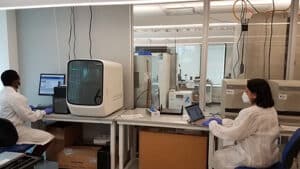
Vaidehi Jobanputra, PhD, NYGC’s Director of Molecular Diagnostics and Head of the NYGC Clinical Lab (right), with Senior Clinical Laboratory Supervisor Dino Robinson
To date, the NYGC Clinical Lab, led by Vaidehi Jobanputra, PhD, FACMG, Director of Molecular Diagnostics, has conducted COVID-19 testing on more than 1,300 patient samples. One of the lab’s chief clients for these tests is the United Nations, which has particular need for rapid turnaround times given its members’ often last-minute travel schedules. Though the lab has a contractual duty to deliver results in 24-72 hours, the team, working in partnership with on-site staff from Renegade Bio, is often outperforming expectations by delivering results within four hours or the same day.
The lab is currently running the FDA-approved BGI test for its COVID testing for the United Nations. The test utilizes real-time reverse transcription polymerase chain reaction (“RT-PCR”) to detect SARS-CoV-2 nucleic acid and is a laboratory-developed test. It has not been approved by the U.S. Food and Drug Administration (FDA), but its use is permitted under the enforcement discretion granted by the FDA to the NY State Department of Health on March 12, 2020 to expedite availability of COVID-19 testing. This test is intended for clinical purposes only. The laboratory has also validated a new lab-developed RT-PCR test to detect SARS-COV-2 nucleic acid by streamlining the RNA extraction process and the multiplexing of the conventional CDC assay. The FDA has given the NYGC permission to offer this test while FDA review of the test validation is pending.
The lab has also recently undertaken several other new projects, including conducting clinical WGS testing for cardiac phenotypes. This cardiac project is just getting under way, and the lab’s first case is a testament to the power of clinical WGS. The patient, a young male with previously negative genetic testing and a family history of sudden death, was found by WGS to have a pathogenic variant in the Phospholamban (PLN) gene. This finding enabled targeted therapy, tailored monitoring based on reported progression of cardiac phenotypes, and targeted testing for other at-risk family members. The coming months will be an exciting time in the lab as the team receives additional samples for this new project as well as other ongoing projects.
Vaidehi is also a co-author of The Medical Genome Initiative: Moving Whole-Genome Sequencing for Rare Disease Diagnosis to the Clinic, published in Genome Medicine in late May. This study is the inaugural publication from the Medical Genome Initiative, the multi-institutional consortium that aims to expand access to high-quality clinical whole genome sequencing for the diagnosis of genetic diseases through the publication of common laboratory and clinical best practices.
Technology Innovation Lab Collaborates on Multi-Institutional Genomic Tool Studies
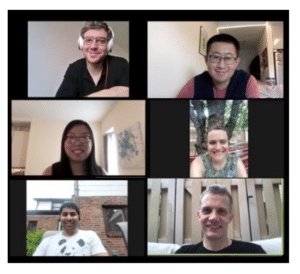
CONNECTING VIRTUALLY: A recent Zoom screenshot of Technology Innovation Lab team. Counterclockwise from bottom right: Peter Smibert, Kunal Pandit, Stephanie Hao, Ivan Raimondi, Chao Yan, and Eleni Mimitou. Follow the team on Twitter at @NYGCtech.
“How do I pronounce ECCITE-seq? Like you’re EXCITED to be doing it.”
The first line of the NYGC Technology Innovation Lab’s FAQs on its CITE-seq.com page ensures correct pronunciation of the lab’s increasingly popular method for multimodal single cell functional genomics that the team published in 2019. While the current focus of the lab is developing new, yet-to-be-revealed methods, the team has collaborated on some new efforts that improve upon the technique and use it to address fundamental biological questions. Two such studies were posted on bioRxiv in June:
Eleni Mimitou, PhD, Senior Research Scientist, and Peter Smibert, PhD, Senior Manager, are co-authors on this NYU/ University of Copenhagen-led collaborative study with University of Connecticut and University of Massachusetts researchers, which is a technical deep-dive into CITE-seq and ECCITE-seq, with protocol optimizations and important implications for panel design. Check out the tweetorial from first author Terkild Brink Buus, PhD, of NYU School of Medicine and University of Copenhagen, that outlines the study’s key points.
- Characterizing the molecular regulation of inhibitory immune checkpoints with multi-modal single-cell screensEleni and Peter are also contributors to a new study, led by Efthymia Papalexi, a graduate student in the Satija Lab, which details using ECCITE-seq to explore the molecular framework of inhibitory immune checkpoint molecules, such as PD-L1, that are frequently overexpressed in human cancers and can lead to the suppression of T cell-mediated immune responses. The study identifies a novel mechanism for the regulation of immune checkpoints and also introduce mixscape, a toolkit for better resolution and interpretation of single-cell screens, which is available to the scientific community via the Satija Lab site here.
In the last quarter, the team bid farewell to Will Stephenson, who was the longest-serving member of the lab. Will has moved to Genentech in South San Francisco, where he has taken on the role as Scientist (technology), developing and integrating new sequencing-based technologies into gRED (Genentech Research and Early Development). We miss Will already but are really excited for him in his new role. Before he left, Will finalized his last major work from the NYGC Technology Innovation Lab: Direct detection of RNA modifications and structure using single molecule nanopore sequencing, which was posted on bioRxiv on June 1. This project, a collaborative effort with researchers at Johns Hopkins University and the University of North Carolina, details a novel method, using nanopore sequencing, for probing RNA structure, dissecting long-range RNA interactions, and directly detecting RNA modifications at the single-molecule level.
Peter and team are also excited to be part of the new Center for Integrated Cellular Analysis and supporting its initiatives.
Education and Outreach
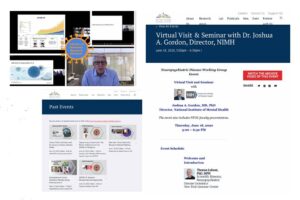
NYGC’s scientific meetings continued virtually throughout the summer, including the biweekly meetings of the COVID-19 Genomics Research Network; Centers of Excellence in Genomic Science (CEGS) virtual lab meetings on June 11 and August 9 for the Center for Integrated Cellular Analysis established at the NYG.; and the NYGC Neuropsychiatric Disease Scientific Working Group-sponsored “virtual visit and seminar” with Joshua A. Gordon, MD, PhD, Director, National Institute of Mental Health (NIMH) held on June 18. This latter event, moderated by Thomas Lehner, PhD, MPH, Scientific Director of Neuropsychiatric Disease Genomics, NYGC, also included a wide range of presentations from NYGC faculty and staff scientists.
The NYGC website now has a new sub-site of available “Past Events” recordings. This sub-site includes the recording of the NIMH event and other recent working group events, as well as two recent webinars held for our donors regarding NYGC’s work in COVID-19 genomics research.
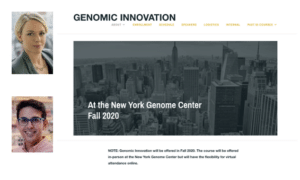
Plans are already forming for an array of virtual events this fall. New York Cancer Genomics Research Network Meetings, moderated by Harold Varmus, MD, returned with a September 1 event following a summer hiatus. The Very Rare Cancer Consortium, which held tumor board meetings/case presentations in May and July, will hold their next event on September 17. The entire NYGC team is encouraged to join us for these upcoming meetings, and the NYGC Events team will be sending Outlook invites as reminders throughout the fall and winter. All upcoming event information is also posted in the Events section of the NYGC website.
This fall 2020 semester also brings the return of the Genomic Innovation graduate course taught by NYGC Core Faculty Members Tuuli Lappalainen and Neville Sanjana, PhD. For the latest information on the course, visit its website, https://genomicinnovation.org/.
HR UPDATE
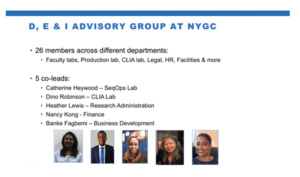
Diversity, Equity & Inclusion Advisory Group Plans and Year-to-Date NYGC Service Anniversaries
The July 30 All Hands meeting included a presentation by Banke Fagbemi, PhD, Director, Business Development, and a co-lead of NYGC’s Diversity, Equity & Inclusion Advisory Group (DE&I AG), outlining its plans and activities. If you missed this presentation, it’s available on the #diversityandinclusion Slack channel or by clicking here. The DE&I AG is also working with the NYGC Communications team to develop content for the NYGC website.
One of the planned activities of DE&I AG is to showcase ongoing stories about NYGC team members on the NYGC website and through social media. One inspiration for idea was the diversity of NYGC voices – and languages! – that were featured in the video filmed last year as a thank you to the Simons Foundation and The Carson Family Charitable Trust for their $125 million gift to the NYGC. So watch for these profiles, coming soon!
See below to recognize and celebrate NYGC Service Anniversaries year to date! Going forward, we’ll be regularly featuring service anniversaries in our newsletter, while new hire and promotion news will be announced via emails by HR throughout the year.
JANUARY 2020 – AUGUST 2020 SERVICE ANNIVERSARIES
8 Years
March: Soren Germer, Dayna Oschwald
April: Avinash Abhyankar, Nico Robine
7 Years
February: Uday Evani
April: Jade Carter
May: Tanya Hemrajani
June: Will Liao
July: Angela Escoffery
6 Years
January: Andre Corvelo, Patricia Klecanda, Izabela Jaroszynska, Tuuli Lappalainen
February: Chris Black, Cristyn Kells, Melissa Marton, Kaz Wrzeszczynski
March: Maria Hodges-Perez, Vaidehi Jobanputra, Hemali Phatnani
April: Clint Beilman, Karen Bunting, Kenny Dykes, Shailu Gargeya, Dick Lau
May: Giuseppe Narzisi, Minita Shah
June: Kevin McGhee
July: Steve Brock, Clint Howarth, Jaime McClintock, Tai U, Lara Winterkorn, Mike Zody
August: Carol Ashe, Cat Reeves
5 Years
January: Hannah Goulding, Manisha Kher, Lena Ricioppi, Peter Smibert
February: Andy Caba, Vanessa Felice
March: Kathy Kearns
June: Wilmarys Concepcion, Marcin Imielinski
July: Kristy Kang, Alicia Lam, Silas Maniatis, Kshithija Nagulapalli, Kunal Pandit
August: Wayne Clarke, Atit Raval, Brian Rose
4 Years
January: Cheryl Moore
February: John Coppinger, Robert Furatero, Arlinda Hasandjekaj, Jackie Massaro, Rajeeva Musunuri, Betsy O’Brien, Jim Parker
March: Cameron Karnes
April: Mir Asgar, Congyi Lu, Neville Sanjana
June: Erick Desingco, Delphine Fagegaltier, Tausif Hasan
July: Guney Akbalik
August: Karen Zipern
3 Years
January: Sneha Mallampati, Melissa Prober, Judy Quinn, Tushit Shukla
March: Paul Hoffman
April: Christina Floristean, Danielle Williams
June: William Mauck
August: Charles Gagnon, Sarah Spock
2 Years
January: Walid Zaran
March: Tim Stuart, Harm Wessels
April: Ally Zisimos
June: Noa Liscovitch-Brauer
July: Ian Felstead, Hannah Poisner, Atteeq Rehman
August: Emily Hoelzli, Nancy Kong, Alejandro Mendez-Mancilla, Colette Toal
1 Year
January: Claire Borron, Demetra Catalano, David Knowles, John Morris
February: Saurav Guha, Banke Fagbemi, Jessica Leitner
March: Timothy Chu
April: Dom Biezonski
May: Anna Basile, Laura Pereira, Bingjie Zhang
June: Janet Gonzalez, Cole Khamnei
July: Amanda Thomas-Wilson
August: Salma Mamur, Megan Schertzer, Roshan Sharma
STAYING CONNECTED AT THE NYGC
Be sure to watch your emails for ongoing staff communications from leadership; Outlook invites to upcoming All Hands meetings, virtual social hours and other events; subscribe to/check into NYGC’s various Slack channels; and refer to the Recommended Mental Health Resources posted on the NYGC wiki. The NYGC Communications team also posts regular news updates and maintains a listing of NYGC scientific publications and pre-prints on the nygenome.org website. Follow the NYGC on Twitter at @nygenome.